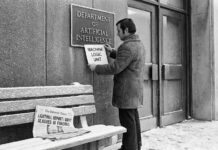
Throughout history, there have been numerous examples of lies and deceptions, perpetrated both by individuals and governments.
These lies have often had extensive consequences, shaping the course of events and in many cases actually altering the course of history.
In this article, we will explore the top 10 biggest lies in history, examining the motivations behind them and the impact they had on the world.
So, without further ado – let’s begin.
The Myth of the Trojan Horse

One of the oldest tales of deception in history is the story of the Trojan Horse. In the story, the Greeks, who were laying siege to the city of Troy, left a giant wooden horse outside the city walls as a supposed offering to the goddess Athena.
The Trojans, thinking it was a gift, brought the horse inside the city walls, not realizing that Greek soldiers were hiding inside. At night, the Greek soldiers emerged from the horse and opened the gates of Troy, allowing the rest of the Greek army to enter and conquer the city.
While the tale of the Trojan Horse is rather interesting and many people believe it to be true, there is little evidence to suggest that it ever actually happened.
There are no contemporary accounts of the event, and the story only appears in later Greek mythology. It is possible that the story was created as a way to explain the fall of Troy or to glorify the Greek victory.
Interesting fact: The Trojan Horse has become a popular metaphor for a form of deception in which a seemingly harmless object or idea is used to gain access to a target.
The Donation of Constantine

The Donation of Constantine is a forged Roman imperial decree that supposedly transferred authority over Rome and the western part of the Roman Empire to the Pope.
The document was allegedly written in the 4th century by Emperor Constantine I, but it was actually created in the 8th century by an unknown author.
The Donation was used by the Papacy to justify its temporal power over the centuries.
It was widely accepted as genuine until the 15th century when the Italian humanist Lorenzo Valla proved it to be a forgery.
Despite this, the Papacy continued to rely on the Donation as a basis for its claims to authority until the 19th century. Then the Vatican finally admitted it was all lie.
Interesting fact: The Donation of Constantine was one of the most successful forgeries in history, and its influence can still be seen in the power and wealth of the Catholic Church today.
The Piltdown Man Hoax

In 1912, amateur archaeologist Charles Dawson claimed to have discovered the missing link between humans and apes in Piltdown, England.
The Piltdown Man, as it was called, was welcomed as one of the most significant discoveries in human evolution.
However, it turned out to be a complete fraud.
After years of examination, it was discovered that the skull was a fake and had been artificially aged to make it appear older than it was.
The jawbone belonged to an orangutan, and the teeth were filed down to resemble human teeth. The bones were also stained to give them a more authentic appearance.
The Piltdown Man hoax fooled many scientists and experts for over 40 years. It wasn’t until 1953 that the fraud was finally exposed.
Interesting fact: There are theories proposing political or nationalistic motives behind the hoax. Some suggest that the forgery was intended to strengthen British national pride by providing evidence of early human evolution within the country's borders, while others propose that it was a deliberate attempt to discredit evolutionary theory altogether.
Columbus North America Discovery

Christopher Columbus is widely known as the discoverer of America, but that is one of the biggest lies in history. In reality, Columbus never set foot on the mainland of North America, and he was not the first European to visit the Americas.
Columbus made four voyages to the Caribbean and South America between 1492 and 1504, but he believed he had reached the East Indies, not a new continent.
He also encountered indigenous peoples who had been living in the Americas for thousands of years before his arrival.
The myth of Columbus as the discoverer of America was created in the 19th century and this false narrative has been spread in textbooks and popular culture ever since.
Interesting fact: One of the earliest documented European explorers to reach North America was Viking explorer Leif Erikson. Around the year 1000 AD, Erikson led an expedition from Greenland to explore the lands westward. He is believed to have landed in present-day Newfoundland, Canada, establishing a settlement known as Vinland.
The Protocols of the Elders of Zion

The Protocols of the Elders of Zion is a fraudulent document / book that was first published in Russia in 1903. It was purported to be a secret plan by Jewish leaders to take over the world and establish a global Jewish government.
The document was used as propaganda to incite anti-Semitic sentiments and was widely distributed in Europe and the United States during the early 20th century.
Despite being exposed as a forgery by The Times of London in 1921, the Protocols continued to be used as a tool for anti-Semitic propaganda by various groups, including the Nazi Party in Germany.
The Nazi regime used the Protocols to justify their persecution of Jews and other minority groups during the Holocaust.
The Protocols of the Elders of Zion has been translated into numerous languages and has been distributed in many countries all over the world.
The document has been used as propaganda by various extremist groups, including white supremacists and neo-Nazis.
In 1924, Henry Ford, the founder of Ford Motor Company, published a series of articles in his newspaper, The Dearborn Independent, which promoted the Protocols and other anti-Semitic conspiracy theories.
The articles were later compiled into a book titled “The International Jew: The World’s Foremost Problem.” The book was widely distributed and translated into multiple languages.
Interesting fact: While "The Protocols" purports to be the minutes of a meeting of Jewish leaders plotting to take over the world, it was actually created by agents of the Russian secret police in the late 19th or early 20th century.
The Dreyfus Affair Fabrications

The Dreyfus Affair was a political scandal that rocked France in the late 19th and early 20th centuries.
It involved the wrongful conviction of Alfred Dreyfus, a Jewish army officer, for passing military secrets to the Germans.
The scandal was fueled by anti-Semitic sentiments and political rivalries, and it exposed the corruption and incompetence of the French military and government.
One of the biggest lies in the Dreyfus Affair was the fabrication of evidence against Dreyfus.
The real culprit, Major Ferdinand Walsin Esterhazy, was protected by his superiors and allowed to continue his espionage activities.
The evidence against Dreyfus was forged and manipulated by military officials who were more interested in covering up their mistakes than in finding the real truth.
Interesting fact: The Dreyfus Affair had a big impact on French society and politics. It divided the country into two camps, the Dreyfusards and the anti-Dreyfusards, and sparked intense debates about justice, democracy, and national identity. It also inspired writers and intellectuals, such as Emile Zola, to speak out against injustice and oppression.
The Great Moon Hoax

In 1835, The New York Sun newspaper published a series of articles claiming that a famous astronomer, Sir John Herschel, had discovered life on the moon during his observations with a powerful telescope.
The articles described a fantastical world on the moon, complete with unicorns, winged humans, and even bat-like creatures.
The articles were a complete fabrication, written by a journalist named Richard Adams Locke.
However, many people at the time believed the stories to be true, and the newspaper saw a huge increase in sales.
It wasn’t until several weeks later that the newspaper admitted the stories were false, and that they had been intended as a satire of the sensationalist journalism of the time.
Interesting fact: The Great Moon Hoax is often cited as an early example of "fake news" and the power of the media to shape public opinion.
Operation INFEKTION: The AIDS Conspiracy

During the height of the Cold War, the Soviet Union launched a disinformation campaign aimed at the United States called Operation INFEKTION.
The Soviet Union claimed that the United States had created the HIV virus as a biological weapon and that it had been tested on African populations.
The campaign was successful in spreading the conspiracy theory, and many people around the world believed that the United States was responsible for the AIDS epidemic.
It wasn’t until years later that the truth was uncovered: the AIDS virus is a naturally occurring virus that likely jumped from primates to humans in the early 20th century.
Interesting fact: The Soviet Union's disinformation campaign was part of a larger strategy to undermine the credibility of the United States and other Western countries. The campaign was also used to distract attention from the Soviet Union's own problems with public health and human rights
Hitler’s Diaries Forgery

In 1983, the German news magazine Stern announced the discovery of what it claimed were the personal diaries of Adolf Hitler.
The diaries, which were supposedly written during the Second World War, were welcomed as a major historical find and were expected to provide a new view on Hitler’s thoughts and actions during the war.
However, it soon became clear that the diaries were in fact a complete forgery.
Experts who examined the diaries found that they contained a number of anachronisms and inconsistencies that made it clear that they could not have been written by Hitler himself.
The revelation that the Hitler diaries were a forgery was a major embarrassment for Stern and for the historians who had initially believed in their authenticity.
It also raised serious questions about the reliability of historical documents and the methods used to authenticate them.
The forgery was eventually traced back to Konrad Kujau, a notorious forger who had previously been convicted of producing fake Nazi memorabilia.
Kujau had sold the diaries to Stern for a large sum of money and had managed to convince the magazine’s editors that they were genuine.
Interesting fact: The Hitler Diaries forgery was made into a TV drama-documentary series in 1991, starring Jonathan Pryce as Konrad Kujau.
Recommendation: If you're really interested in Hitler Diaries we would greatly recommend following book: "Selling Hitler: The Story of the Hitler Diaries."
The Tobacco Industry on Cigarette Smoking

The tobacco industry has a long history of denying the harmful effects of cigarette smoking.
For decades, they spent millions of dollars on advertising campaigns that portrayed smoking as glamorous and sophisticated, while completely downplaying the risks associated with smoking.
In the 1950s, research began to emerge linking cigarette smoking to lung cancer and other health problems.
However, the tobacco industry denied these findings and even went as far as to fund their own studies to try and disprove the link between smoking and cancer.
It wasn’t until the 1990s that the tobacco industry finally admitted that smoking was harmful and addictive.
This admission came after years of lawsuits and public pressure.
Today, as we all know, the tobacco industry is heavily regulated and cigarette packaging is required to carry warning labels about the dangers of smoking.
Interesting fact: In 1998, major tobacco companies agreed to pay $206 billion to 46 states in the United States to settle lawsuits related to the health care costs of smoking.




























